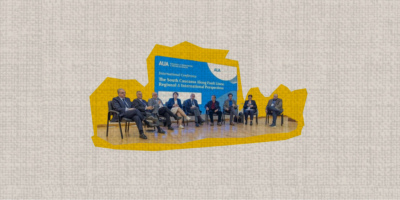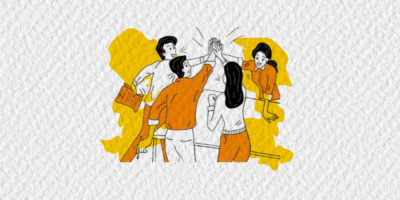
On Sept. 9, students, faculty and guests gathered to honor William Saroyan, Armenian-American writer whose works still echo with humor, resilience and a stubborn kind of hope.
The event, co-organized with the William Saroyan Foundation, brought together students, faculty and guests for a series of readings and discussions. It was part of Saroyan Days in Yerevan, a weeklong festival celebrating his legacy. At AUA, it took the form of an evening of readings that pulled together perspectives from Armenia, the diaspora and beyond.
The evening started with AUA Provost Dr. Alina Gharabegian welcoming the audience, noting that the gathering was more than just a literary program. She emphasized the significance of coming together “in the name of literature” and expressed gratitude to the William Saroyan Foundation and its president, Scott Setrakian, for bringing the event to campus.
Setrakian, president of the William Saroyan Foundation, reflected on the writer’s confidence that his stories would outlast him, a belief recently reinforced by the publication of “22 Unpublished Stories.” He described Saroyan’s philosophy as one of “defiant optimism,” a message he believes resonates strongly with young people in Armenia and beyond.
When asked about Saroyan’s relevance to today’s readers, Setrakian was careful to note his perspective as an American. “I want to be very careful about presuming that I understand the motivation specifically of young Armenians, because I’m an American and I don’t know specifically the challenges that they face,” he said. “However, I’m also a father of boys that are in that age group, and I think more broadly, that Saroyan’s message of defiant optimism…is a philosophy that is very applicable to young people anywhere, and I think also in Armenia.” Setrakian acknowledged that publishing Saroyan’s works in Armenia first had both practical and symbolic reasons. “There’s a market in Armenia that remains deeply interested in his writing,” he said. “It shows that even today, his words find a home here.”
Reflecting on the broader purpose of such programs, Setrakian claimed that there is no single answer. “It’s more ambition and aspiration than knowing with certainty that it’s going to help,” he said. “The writing is so good, and I hope it helps.”
Among those in attendance, Lana Melikyan, a senior EC student, described the evening as both intellectually stimulating and emotionally resonant. “I was looking forward to the readings from the faculty, because I was curious to see which texts they would choose,” she said. “The title “Unpublished Stories” caught my attention immediately, as you want to be the first one to hear them.”
Melikyan pointed to passages that felt deeply Armenian. “I loved the introduction of the “Hushamadyan” and also Laurie Alvandian’s reading of the prayers,” she said. “It gave me insight into the Armenian way of thinking and writing.”
Laurie Alvandian, director of AGBU Papazian Library, was among the readers on stage. She described the personal meaning of celebrating Saroyan’s legacy.
“Growing up in the diaspora, Saroyan was the only Armenian literary name that I knew of for a long time,” Alvandian said. “When I read his works, it would spark a lot of questions in my mind about my own identity and my own experience as an Armenian in the U.S. Apart from that, as someone who loves words and literature, being able to read a famous Armenian’s work felt very special to me.”
She emphasized Saroyan’s ongoing relevance. “His work deals closely with the immigrant experience and all the complicated emotions that come with feeling both at home and like a foreigner at the same time,” she said. “This feeling of belonging to multiple places, of connecting across cultures, as well as the displacement and disconnect felt when struggling to relate to others, is something that I think can resonate with young people and young Armenians.”
The Saroyan Days celebration was not only about honoring a celebrated Armenian-American figure but also about connecting past and present, Armenia and diaspora, literature and lived experience.
As Alvandian observed, Saroyan’s legacy lies in showing that “our ‘Armenian-ness,’ whatever form that takes or what it might look like, links us all together across time and place.”
For AUA students encountering his work for the first time, the evening opened a window onto a literary giant whose themes remain relevant to this day. For the diaspora, it reaffirmed the shared cultural fabric that binds Armenians worldwide. And for the Saroyan Foundation, it was a reminder that the writer’s voice—playful, defiant, optimistic—continues to inspire across generations.
In a city still grappling with questions of identity, resilience and belonging, Saroyan’s words proved that literature can offer not only reflection but also direction.












